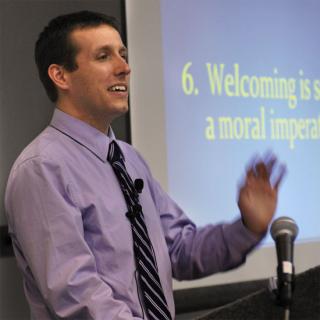Listening to Experience

General Assembly 2008 Event 3042
Presenters: Rev. Harlan Limpert, Director of District Services for the Unitarian Universalist Association (UUA); Rev. Thom Belote, minister of Shawnee Mission Unitarian Universalist (UU) Church in Overland Park, Kansas.
Rev. Limpert began by asking those assembled to try a quick quiz: guess the current adult membership of the UUA, the average annual growth rate of the UUA over twenty years, the number of new members per congregation added each year, and the number of congregations that make up 25 percent of total UUA membership. Nobody in the room was able to answer all four closely, though Limpert still awarded the promised Chevy Corvette and Chrysler PT Cruiser Convertible, both conveniently sized for carrying home on an airplane.
He also compared UU growth (about 1 percent per year over 20 years) with recent figures of “other mainline denominations” including the United Methodists (down 1 percent), Evangelical Lutheran Church in America (down 1.6 percent), Presbyterians (down 2.4 percent), and Episcopalians (down 4.2 percent). He reminded participants that, divided among 1,047 UU congregations, the average 1 percent growth rate means that some congregations grew and some got smaller. And the average growth rate of sixteen congregations identified by the UUA as “breakthrough congregations” because they’d been able to break through barriers to growth and begin to grow more quickly? They grew by 52 percent total over 10 years.
Limpert described a meeting in Louisville, Kentucky, in November 2007, with 12 ministers meeting with Rev. Alice Mann of the Alban Institute and observed by the members of the UUA Growth Team. Rev. Thom Belote described his own experience as a participant, and as minister of one of the fast-growing congregations, Shawnee Mission UU Church. He described how, at this meeting, those participating identified some common threads of what had helped with their growth—though he cautioned that there is “no magical secret.” Excerpts from these conversations in 2007 have been provided via video, either as a DVD that can be ordered or as online videos (see Listening to Experience: DVD and Windows Media).
Belote then summarized those common threads the ministers identified:
- A “saving message.” A life-transforming, hopeful message. Each congregation’s was different, but all were clear. Ministers found them easy to articulate. Each message communicated that, in participating in the life and ministry of the congregation, “your life is profoundly changed.”
- A purpose. This, too, could be easily communicated. “If nobody can remember it, you don’t have one,” Belote added.
- The congregation balances “looking in” and “going out.” One minister described how the congregation moved from simply sharing the plate with various groups once a month, to focusing on “a few things we can always return to”—finding the common thread of values. “The world tempts us with so many things,” and in connecting their spiritual life with the rest of the week, the congregation finds a balance. Belote shared that he uses the metaphor that we are a “beacon faith” and not a “bunker faith.”
- Excellent worship. Many congregations are casual about worship, and fast-growing churches tend to have more quality and focus on excellence. The minister has a key role in what happens in worship in these churches; Belote said that he, as minister, takes the “bad Sundays” where attendance is often low, often using an “especially catchy title.” There isn’t one single form that makes for “excellence,” but some common elements are:
- Relevant to life experience
- Emotionally affecting
- Recharging and renewing
- Inspiring to make change in the world
- There’s “buzz”! There’s a sense in the congregation that its “spirit is moving,” that it’s bursting out into the community. There’s a sense, as one minister in the video said, that people are sharing con toda me vida. How can a congregation identify “buzz”? Questions to ask are: Is there energy, brightness, and electricity in the air when people walk into church? Do people mope in or enter with excitement? “You can often tell even before walking in the front door” whether it’s a lively, vital place.
- Welcoming is seen as a moral imperative. A clip of Rev. Peter Morales from the video was used to illustrate, where he shared that he as minister started being part of Sunday’s greeting of people as a matter of responsibility, but now it “grabs” him. “You start doing because you ought to and it changes,” Morales said. Belote talked about the importance of “welcoming the stranger” and the need for it to be genuine, not faked.
- Role of the minister. In these fast-growing churches, ministers use their power to protect the health and wellbeing of the congregation, to set boundaries. This requires strength and self-awareness on the part of the minister.
- Leadership addresses growth. Those congregations that are growing explicitly address growth issues. There’s sometimes concern that growth is too success-focused, too evangelical. Sometimes, the pulpit is used to respond to this discomfort—humorously, with an edge, or softly. Belote said that he often responds to discomfort with the statement, “Isn’t this a great problem to have?”
- Willing to try new things and fail. Though excellence is also important, growing congregations are brave enough to try new things and fail. Risk is important. “Allow things to arise and to soar or fall.”
- All you need is love. The minister’s love and affirmation of the congregation is crucial, drawing on the power of love to transform community. One minister in the video suggested how important it is to answer a call only if one can love the congregation.
This formal presentation was followed by two minutes of silence, in which participants were asked to identify one thing that they would do in their congregations, inspired by the presentation. Participants were then asked to come to the microphone individually and share their commitments to action.
Reported by Jone Johnson Lewis, edited by Dana Dwinell-Yardle